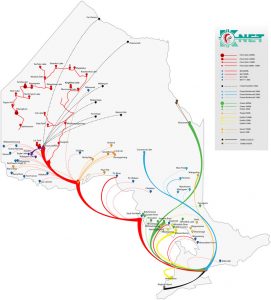Another one of Industry Canada’s Connecting Canadians initiative was First Nations SchoolNet. This program funded connectivity, equipment, content development, software, and IT helpdesk services. At its peak, it supported some 600 First Nations schools and learning centres, 5,000 teachers, and 80,000 students. Below, you can follow a link to watch a short video about First Nations SchoolNet produced by KNET.
Sharing our ICT Stories: First Nation SchoolNet (Flash video)
An important component of First Nations SchoolNet was the capacity-building initiatives it supported. This led to a series of regional non-profit Indigenous technology organizations that often partnered to support mutually-beneficial development efforts. In 2002, these organizations gained control over First Nations SchoolNet’s program design and delivery. These so-called regional management organizations set up a national network to discuss challenges, best practices, and strategic development. The network became known as the Assembly of First Nations’ ICT Working Group. Over the years, these organizations have collaborated on many ICT4D initiatives.
First Nations Regional Management Organizations
| Region |
Organization |
Acronym and Link |
| B.C. | First Nations Technology Council (in partnership with the First Nations Education Steering Committee) | FNTC |
| Alberta | Technical Services Advisory Group | TSAG |
| Saskatchewan | Keewatin Career Development Corporation | KCDC |
| Manitoba | Keewatin Tribal Council working with Broadband Communications North | KTC (BCN) |
| Ontario | Keewaytinook Okimakanak K-Net Services | KO-KNet |
| Quebec | First Nations Education Council | FNEC |
| Atlantic Region | Atlantic Canada’s First Nation Help Desk | FNHD |
Dr. Adam Fiser, who now co-leads the Indigenous and Northern Communities group as an Associate Director with the Conference Board of Canada, wrote this backgrounder about First Nations SchoolNet and the Regional Management Organizations in 2004.
As was the case with CAP, despite positive evaluations from government funders and support from communities, First Nations SchoolNet faced continual funding challenges. In 2006/2007 responsibility for the program was transferred to Aboriginal Affairs and Northern Development Canada. There, it became part of the broader New Paths in Education initiative. At present, the long-term sustainability of New Paths in Education remains uncertain. Although the national network of regional management organizations do not meet as regularly as they once did, many remain in contact through the AFN’s connectivity group, the First Mile Connectivity Consortium, and the annual Indigenous Connectivity Summit.
Connecting Canadians initiatives are just a few of the ways that government has supported connectivity in Canada. A news article from CBC (Mar. 25, 2014) describes a funding announcement for Indigenous broadband from the federal government’s 2014 budget. The government announced a five-year, $305-million plan to improve connectivity to 280,000 households and businesses. It suggests that community-driven broadband initiatives may support infrastructure development.
Recently, this work has been reflected in government funding initiatives associated with broadband infrastructure development. For example, the Universal Broadband Fund and the CRTC Broadband Fund support initial infrastructure builds, including Indigenous projects such as Mishkeegogamang Ojibway First Nation (K-Net in Ontario), Goodfish Lake (Arrow Technologies Inc/TSAG in Alberta), several First Nations in Manitoba (BCN), and communities and households across Nunvik (Tamaani in Quebec).
As mentioned in previous pages, High-Speed Access for All: Canada’s Connectivity Strategy announced the intention of closing the digital divide and the Universal Broadband Fund makes federal money available for local infrastructure projects. These initiatives are in accordance with the TRC Calls to Action and UNDRIP, which now provide guides to Canada’s policies affecting Indigenous people, and which, among other goals, aim to end economic, educational and health disparities, while support self-determination.
K-NET – Ku-Ke-Nah
We now will turn our focus from government-led initiatives to those led by Indigenous peoples. A First Nations owned and operated organization, K-Net provides ICTs, “telecommunication infrastructure and application support in First Nation communities across a vast, remote region” of Canada. K-NET services, which connects over 100 First Nations in Ontario and many other communities, is the largest Indigenous-owned and operated telecommunications services company in the world. It has partnered on fibre broadband rollouts across thousands of kilometers of Canadian Shield and installing community satellite dishes and cell phone towers on the tundra up to Hudson Bay. Here is a map of K-Net’s services:

Map of K-Net’s Network from: https://knet.ca/kuh-ke-nah-networks/
Below, follow the link to watch a video conversation between Margaret Fiddler and Brian Beaton, two friends who has since passed away, but were involved in KNET since its earliest days. Later, we’ll hear more from people who are working for the organization today.
Video: Margaret Fiddler & Brian Beaton – Full Interview (Flash video)
(From bush trails to digital highways: First Nation Innovation and KO-KNET. Sioux Lookout, ON, 2013)
